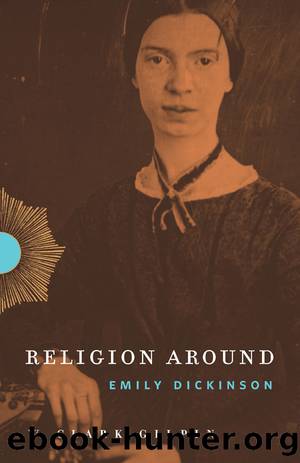Religion Around Emily Dickinson by W. Clark Gilpin

Author:W. Clark Gilpin
Language: eng
Format: epub
ISBN: 9780271064765
Publisher: The Pennsylvania State University
Published: 2014-08-15T00:00:00+00:00
AN INTIMATE ABSENCE
Emily Dickinson held tightly to the world, demanded much from her friends, and feared that departures would become permanent. As she remarked in a letter to her close friend Samuel Bowles, the editor of the Springfield Republican, âmy friends are my âestate.â Forgive me then the avarice to hoard them!â1 Perhaps surprisingly, her decision for seclusion did not diminish but instead accentuated this powerful attachment to those from whom she found herself separated by distance, by her own design, by death. In her writing, Dickinson imaginatively amplified the experiences of absence, separation, and loss and set them in tension with experiences of presence, intimacy, and reunion. Solitudeâwhether at the writing desk or in the gardenâbecame imagined intimacy with a separated, perhaps unattainable, object of desire. Indeed, separation heightened desire. Dickinson accentuated this simultaneity of separation and presence, intimacy and absence, by exploiting the metaphorical possibilities of the nineteenth centuryâs most widely practiced form of writing: the letter.2
Among the spiritual disciplines of solitude, journals and diaries typically created private reservoirs from which writers subsequently drew material either for personal reflection or for revision into public writing and oratory. As I discussed in chapter 2, the eighteenth-century New England evangelicals Jonathan Edwards and Sarah Osborn regularly reviewed their diaries as a spiritual exercise, and Ralph Waldo Emerson kept carefully indexed journals as storehouses of ideas for revision into lectures and essays. Lavinia Dickinson kept a diary, but Emily Dickinson did not.3 Letters, on the other hand, were composed for the express purpose of connecting the writer to family, friends, and the intimate circle within which the letters would be read aloud and circulated. Following standard conventions in the long cultural history of the familiar letter, nineteenth-century correspondents portrayed their letters as bridges, spanning absence, loss, or separation, including, symbolically, the separation of death. As they traveled from one household to another, letters thus mediated intimacy, and handwriting became the emblem of writers touching across distance. Furthermore, when the nineteenth-century letter traveled, it typically traveled with luggage. Enclosuresâlocks of hair, pressed flowers, or sentimental trinketsâwere integral to the handwritten text and its meaning. These epistolary commonplaces framed Emily Dickinsonâs practices of including copies of her poems with her letters, incorporating verse into the body of a letter, and enclosing a pressed flower, a leaf, or other small memento as tangible emblems of connection between correspondents. Paradoxically, in the very act of conveying intimacy and physical objects emblematic of intimacy, the familiar letter accentuated the reality of absence. William Merrill Decker, in his excellent historical study of letter writing in America, has identified a pervasive apprehension on the part of separated, perhaps lonely letter writers that âdeath will intervene before the parties can reunite.â4
These long-standing conventions of the familiar letter implied that separation was permanent, that reunion might never occur, and that only the traces of a lost intimacy would remain. Or they raised the possibility that the desire for intimate communication would remain forever unfulfilled. The notion that the object of
Download
This site does not store any files on its server. We only index and link to content provided by other sites. Please contact the content providers to delete copyright contents if any and email us, we'll remove relevant links or contents immediately.
4 3 2 1: A Novel by Paul Auster(11788)
The handmaid's tale by Margaret Atwood(7446)
Giovanni's Room by James Baldwin(6806)
Asking the Right Questions: A Guide to Critical Thinking by M. Neil Browne & Stuart M. Keeley(5355)
Big Magic: Creative Living Beyond Fear by Elizabeth Gilbert(5350)
Ego Is the Enemy by Ryan Holiday(4953)
On Writing A Memoir of the Craft by Stephen King(4659)
The Body: A Guide for Occupants by Bill Bryson(4579)
Ken Follett - World without end by Ken Follett(4441)
Bluets by Maggie Nelson(4258)
Adulting by Kelly Williams Brown(4231)
Eat That Frog! by Brian Tracy(4147)
Guilty Pleasures by Laurell K Hamilton(4115)
White Noise - A Novel by Don DeLillo(3828)
The Poetry of Pablo Neruda by Pablo Neruda(3813)
Fingerprints of the Gods by Graham Hancock(3731)
Alive: The Story of the Andes Survivors by Piers Paul Read(3726)
The Book of Joy by Dalai Lama(3693)
The Bookshop by Penelope Fitzgerald(3615)
